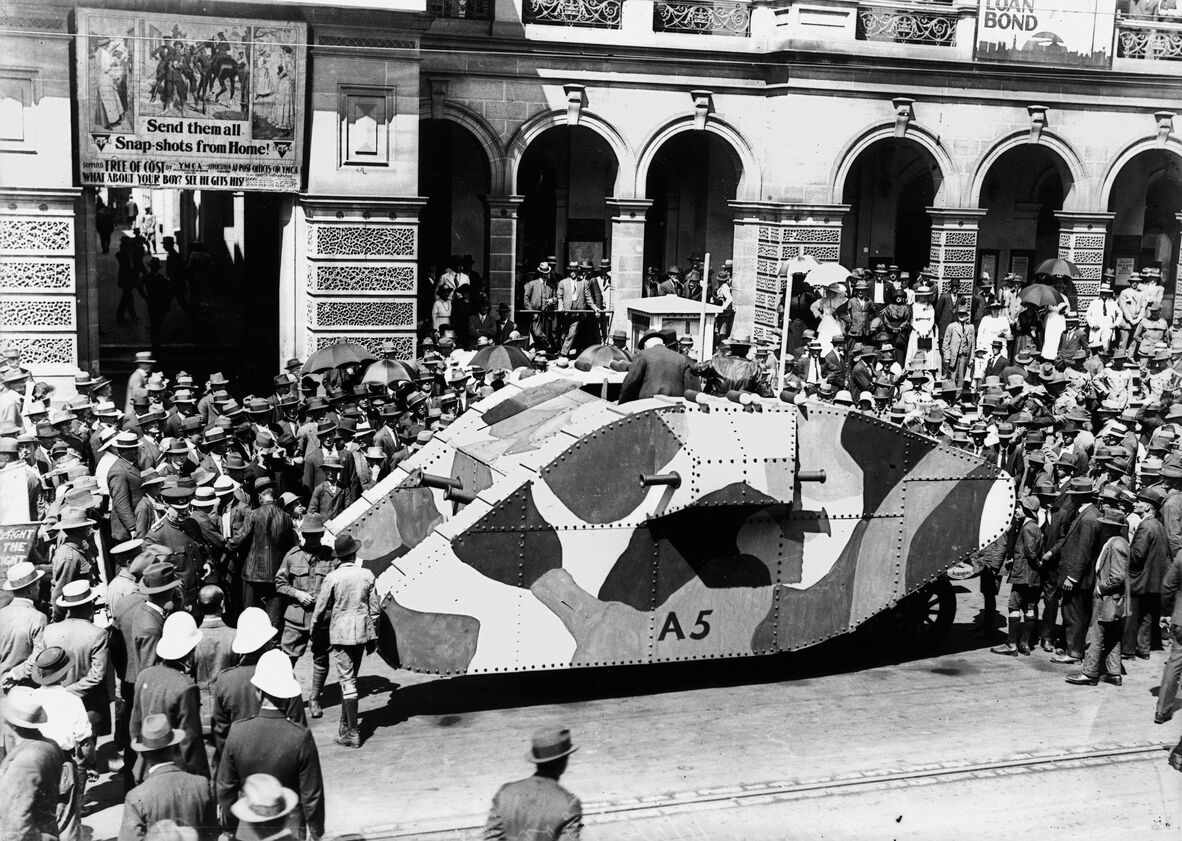Here’s one tank you can bank on
By Greg Corbett, Engagement Officer, Anzac Square Memorial Galleries | 7 January 2025

A prize draw in a 'tank' at the General Post Office in 1918. ‘Page 28 of The Queenslander Pictorial, supplement to The Queenslander’, 18 May 1918. John Oxley Library, State Library of Queensland, Image number: 702692-19180518-s0028
War is an expensive business. To finance military expenditure during World War I, the Australian government issued war bonds that were made available to all Australians, including soldiers serving overseas.

A poster promoting war bonds, depicting a tank on the battlefield. ‘Seventh war loan war bonds, like tanks, break the Huns’ ranks’, 1918, John Sands (Firm) and N.S.W. Central War Loan Committee, State Library of Queensland.
The First War Loan was announced on 1 July 1915 and raised £13,000,000, well above the asked for amount of £5,000,000. However, by 1918 much larger sums were needed, and the Sixth and Seventh War Loans each set targets of £40,000,000. Various publicity stunts were held to help achieve this ambitious target, and 'Tank Banks' were one such method of encouraging people to open their wallets and invest.

British Mark IV tanks were used in the Battle of Cambrai. British Mark IV Tadpole tank, Public Domain.
Tanks first went into action at Flers-Courcelette during the Battle of the Somme in September 1916. In November of the following year, the British Tank Corps achieved a concentrated breakthrough at the Battle of Cambrai, and subsequently a battered tank known as 'Egbert' was recovered from the battlefield and displayed in Trafalgar Square, where people could buy war bonds and certificates. Following the success of this initiative, more tanks were recovered from France and toured around England, with a competitive league established to see which town could raise the most money. West Hartlepool took out the top spot, raising a staggering £2,367,333. The reward was that Egbert the Tank was theirs to keep!
Brisbane residents were treated to a "tank" visitation of their own in April 1918, with the establishment of a 'Tank Bank' in Queen St outside of the General Post Office. The tank itself was actually a replica, made "in exact conformity with picture representations of those used by the British on the West front." (The Telegraph 1918)

‘Crowds gather to see a tank outside the General Post Office in Brisbane during World War I.’, 2005, John Oxley Library, State Library of Queensland, Negative number: 135089
The event was assisted by impassioned appeals to the crowd by guest speakers atop the tank. One such speech was delivered with a poetic flourish by a Lieutenant Little, a blind returned soldier who implored those present to invest in war bonds by saying, "If they could not shoulder rifles, they could shoulder war bonds. They could bind themselves with golden chains of sympathy to the gallant men now fighting for the maintenance of the Empire." (The Telegraph 1918) The initiative was a resounding success, with £75,000 raised in just 5 minutes.
For all their publicity-grabbing power and success at war fundraising, World War I tanks did not linger long in public affection, and most ended up being scrapped after the war. In 1937, despite earlier stupendous fundraising efforts to secure the tank in the first place, West Hartlepool local councillors debated whether to keep or scrap Egbert. In a vote framed around whether it represented a vital lesson of war or was a "relic of barbarism", the outcome was 20 to 12 in favour of scrapping the tank.
References
‘Crowds gather to see a tank outside the General Post Office in Brisbane during World War I.’, 2005, John Oxley Library, State Library of Queensland, Negative number: 135089, https://onesearch.slq.qld.gov.au/permalink/61SLQ_INST/1dejkfd/alma99183506230502061
‘How Britain Invented the Tank in the First World War’, 2024, iwm.co.uk, viewed 17 December 2024, https://www.iwm.org.uk/history/how-britain-invented-the-tank-in-the-first-world-war
‘Seventh war loan war bonds, like tanks, break the Huns’ ranks’, 1918, John Sands (Firm) and N.S.W. Central War Loan Committee, State Library of Queensland, https://collections.slq.qld.gov.au/viewer/IE438713
‘Page 28 of The Queenslander Pictorial, supplement to The Queenslander’, 18 May 1918. John Oxley Library, State Library of Queensland, Image number: 702692-19180518-s0028, https://onesearch.slq.qld.gov.au/permalink/61SLQ_INST/tqqf2h/alma99183906501202061
'Research Guide: First World War', n.d., Reserve Bank of Australia Unreserved, viewed 17 December 2024, https://unreserved.rba.gov.au/nodes/view/46006
'Tank Banks and Souvenirs', 2016, The Tank Museum, 23 March 2016, viewed 17 December 2024, https://tankmuseum.org/article/tank_banks
‘Tank: Life and Times of a 'Wonder Weapon'', 2011, BBC History, 17 February 2011, viewed 17 December 2024, https://www.bbc.co.uk/history/worldwars/wwone/gallery_tank_04.shtml
'TANK WEEK', 1918, The Telegraph (Brisbane, Qld. : 1872 - 1947), 3 April 1918, p. 4. (SECOND EDITION), viewed 17 December 2024, http://nla.gov.au/nla.news-article176064018
'The War Loan.', The Telegraph (Brisbane, Qld. : 1872 - 1947), 3 April 1918, p. 2. (SECOND EDITION), viewed 17 December 2024, http://nla.gov.au/nla.news-article176064089
'When Egbert the tank visited Darlington and Durham to extort war effort money', 2018, The Northern Echo, 3 April 2018, viewed 20 December 2024, https://www.thenorthernecho.co.uk/history/16128221.egbert-tank-visited-darlington-durham-extort-war-effort-money/
Comments
Your email address will not be published.
We welcome relevant, respectful comments.